Why Hasn't America Elected A Woman As President

A white oak and mahogany desk sits in front of a portrait of George Washington which hangs over the fireplace. In front of the fireplace two sofas face each other on a traditional dark blue carpet. The carpet bears an image of an eagle holding an olive branch in its right talon and arrows in its left, with a shield bearing thirteen stripes; above it thirteen stars in an arc are sewn into the carpet. An ornate grandfather clock to the right of the fireplace stands next to a door leading out into the Rose Garden. Three windows with golden drapes are behind the desk looking out over the South Lawn. This is one of the highest elected offices in the world.
The Oval Office.
In nearly 250 years only men have sat behind this desk.
Two women have come close, but a woman has never called this office home: has never signed executive orders, has never addressed the nation from this office. Kamala Harris supporters dared to hope that her bid for election in 2024 would see the inauguration of the first female president. They were sorely let down.
So, the question remains… will the US ever elect a woman to the presidency?






'The Last Man on Earth' was released in 1924, and was the the first film to feature a women as president of the United States after a disease kills all males aged over fourteen years old.
'Hail To The Chief' aired on ABC between April and May 1985. The show focused on President Mansfield's attempt at balancing her political career with raising her family.
At the end of season five of 'House of Cards', Claire Underwood is sworn in as president after the death of her husband Frank. In the first episode of season six we see Claire deal with death threats now that she is president.
Ellen Clermont-Diaz is running for re-election as President after a successful first term in office.
“I was 28 when I was elected to the state legislature. I had 150,000 constituents, now, I have 300 million. They need me to be realistic so they can be idealistic.”
The concept of a female president isn’t unheard of, in fact it has been an element of science fiction for 100 years. Over this period, numerous films, books and even songs have featured a woman as president.
Christina Wolbrecht, a Gender and Politics Professor at Notre Dame University in Indiana, says “I think science fiction is a place in which we imagine a future we would like to see.”
What is stopping a woman from being elected as president?
Video from The Late Late Show with Stephen Colbert YouTube
Created by Amy Woodward
Created by Amy Woodward
Candidates

Video cbsnews on TikTOk
After the Revolutionary War, delegates from twelve of the original thirteen states met in Philadelphia to write the American Constitution, outlining the government and people’s rights. Article two of the constitution establishes the requirements and method of electing the president, in turn setting up the electoral college.
Professor Wolbrecht says, “We have a presidential system, and we have known for forty years that is bad for women.”

Since the inception of the constitution the criteria for who can be president has stayed the same, but the personality traits a voter looks for in a candidate has changed. Now candidates not only need to be seen as a strong leader, intelligent and charismatic, but good at public speaking, presentable and entertaining.
The Inter-University Consortium for Political and Social Research (ICPSR) says that important influences on the vote are “experience, honesty, morality, compassion, competence and leadership ability of the candidate.”
Biaya Kayembe, a voter from Missouri, said “I thought Harris was a great candidate, but she wasn’t what Americans needed to save the country.” Jennifer Ewing, a member of Republicans Overseas, said “most people will agree he is very authentic, which is appealing, especially when the other candidate is Kamala Harris who is vastly unpopular.”
Daron Shaw, a politics professor at the University of Texas, says that elections in the US “often hinge on personality and background”. He believes that there is little opposition to a female candidate based on surveys and trait literature.
"People are more likely to think that women are less corrupt and will work collaboratively. They are more likely to think men will get things done and be able to make decisions."
Video by Amy Woodward
Video by Amy Woodward
Data visualisation created by Amy Woodward using data from YouGov Survey (July 31 2024)
Data visualisation created by Amy Woodward using data from YouGov Survey (July 31 2024)
In nine out of ten instances the candidate who wins the popular vote also wins the electoral college and the presidency.
So, why was Hillary Clinton not inaugurated as the first female president in 2016?
Professor Shaw says “The problem in 2016 for Hillary Clinton was not that she was a woman. It was that she was Hillary Clinton.”
Despite entering the campaign with significant political experience, voters viewed Clinton as “knowledgeable but dishonest” according to Presidential Studies Quarterly.
In 2016 the American National Election Study (ANES) surveyed the electorate, asking how voters assessed the candidates character traits. The survey looked at the candidate’s leadership, empathy, competence, integrity, openness/honesty, and amicability. The results showed that both candidates were viewed unfavourably but Clinton had higher positive assessments than Trump. A similar result was seen in 2024 with voters viewing Harris in a more positive light compared to Trump in key character traits such as honesty.
According to a poll in 2018 by Monmouth University, 52% of Americans preferred an outsider candidate. There are two types of outsiders: ‘insider outsider’ and ‘complete outsider’. The ‘insider outsider’ is a candidate who has some political experience but runs their campaign as an outsider, the ‘complete outsider’ is a candidate who runs for office with no political experience. Trump was the first ‘complete outsider’ candidate to win the presidency in 2016 and could be considered an ‘insider outsider’ candidate in 2024.
Campaign

Made by Amy Woodward
Made by Amy Woodward
Video from Fox 5 New York YouTube (July 21 2024)
“Our elections are this 18-month hell, but people get the chance to test the candidates out.”
Christina Wolbrecht - Notre Dame University Gender and Politics Professor
Video from Hannah Ferguson on TikTok
The 2024 election campaign started off the same way all campaigns in the United States do with candidates announcing their intention to run, and in the case of the opposition party, holding primaries and caucuses to decide who their candidate is going to be. That is until July 21st when Joe Biden stepped down from being the presidential nominee, something that had never been done before.
Michael Traugott, a political scientist from the University of Michigan, said “Trump’s campaigns going back to 2016 were organised around trying to assemble a coalition of people who feel left out.” Professor Shaw says “There is a strong pull for outsiders these days. The assumption is that the insiders are not competent so the average voter says, how could it be much worse?” Both Clinton and Harris were insider candidates having worked for the administration before becoming the party’s presidential candidate. Annie – not her real name – is remaining anonymous due to the level of political polarisation. She said the democrats should “have taken a step back” from the campaign to truly consider how feasible Biden was as a candidate. She added, “I don’t know if it should have been Harris from the beginning, but it should not have been Biden.”
Jordan Jone, a voter in Colorado, said initially she thought it was a good move because “people were genuinely talking about how they weren't going to vote for Biden.” But adds that “Harris needed more time.”
Biaya Kayembe said, “I think the only mistake the Democrats made was not running Kamala from the beginning.” Replacing Biden so late in the race was probably one of the biggest missteps the Democrats made during the campaign.
‘Fight: Inside the Wildest Battle for the White House’, by Johnathan Allen and Amie Parnes, talks about the contingency plans already in place if Harris had to take over from Biden. Allen and Parnes write, “what many democratic voters didn’t grasp at the time was that Biden was already on track to lose.”
Professor Wolbrecht believes that replacing Biden was not the Democrats plan all along but there was a definite benefit in not having to hold any primaries and caucuses. He added, “Had they decided earlier the Democrats would have spent all this time fighting. Instead, the party could just focus on opposing Trump.” She did say the one of the problems with this strategy was “people in the community felt they just don't really know if they could trust her.”
A candidate’s stance on issues is another deciding factor for voters. Professor Shaw says, “issues have always been used as a way to attract support, it’s very backwards to most European countries.”
This election the biggest issue for both Democrats and Republicans was the economy; the second biggest issue differed: for Democrats it was healthcare and for Republicans it was immigration. Voters felt that Harris’ messaging was inconsistent going from progressive to centrist.
Gary O’Donoghue, BBC Chief North America Correspondent said, “There are only really two kinds of election campaign you can run. One is ‘we're looking after you’, the other is ‘it's time for a change’. She was caught between the two.”
During campaign stops some of Harris’ answers were seen as elusive, and when she didn’t hold a press conference for ninety days after becoming the nominee, voters became wary of her.
Professor Shaw believes during the campaign the emphasis was put on mobilising supporters instead of persuading voters, a sentiment reflected in his book ‘Battleground: Electoral college Strategies, Execution and Impact in the Modern Era’, which talks about how campaign strategies have changed over time. He says, “campaigns’ incentives shifted from winning hearts and minds within the shrinking pool of potentially 'persuadable' or swing voters to mobilizing likely supporters.”
Data visualisation created by Amy Woodward using data from PEW Research Centre (September 9 2024)
Data visualisation created by Amy Woodward using data from PEW Research Centre (September 9 2024)
Data visualisation created by Amy Woodward using data from USAFacts
Data visualisation created by Amy Woodward using data from USAFacts
Swing States in the 2024 Presidential Election
Swing states are states that could plausibly be won by either party. Because of this candidates spend a considerable amount of time campaigning in these states.
Since 1992, thirty states have voted for the candidate of the opposite party from the previous election at least once.
Arizona
Arizona has a population of over 7.4 million. In 2020 Joe Biden won the state's 11 electoral college votes, he had 0.4% more of the vote than Donald Trump. Biden became the second Democrat to win Arizona since 1948.
Polls show the top issues among voters are the economy, immigration and abortion. Inflation has caused alarm from some voters who blame Democratic President Joe Biden.
Georgia
Georgia has a population of over 11 million. In 2020 Georgia was narrowly won by the Democrats who had a margin of 0.23%. The Democrats were not expecting to win the state's 16 electoral college votes. Donald Trump attempted to overturn the results in Georgia.
The most important issue in Georgia is the economy. Black voters are also important in this state.
Michigan
Michigan has a population of over 10 million with 15 electoral college votes. In 2020 Biden won this state by nearly 2.8%. Key issues in Michigan include the economy, immigration and the auto industry. Michigan also has the largest population of Arab-Americans so the handling of the Israel-Gaza war is also an important issue.
Nevada
Nevada has population of over 3.1 million with 6 electoral college votes. In 2020 the Democrats won this state by nearly 2.4%. Key issues in this state include, unemployment rate, inflation and housing prices.
North Carolina has a population of nearly 11 million with 16 electoral college votes. In 2020 Trump won this state by 1.3%. Key issues in this state include economy, inflation, immigration and natural disaster relief (particularly after Hurricane Helene devastated the state).
Pennsylvania has a population of nearly 13 million with 19 electoral college votes. In 2020 Democrats won this state by nearly 1.2%. Pennsylvania is where Trump was nearly assassinated in July 2024. Key issues in this state include economy, inflation, immigration, fracking, reproductive rights and health care.
Wisconsin has a population of nearly 6 million with 10 electoral college votes. In 2020 Democrats won this state by 0.6%. Key issues in this state include healthcare.
Helen Whiteley, a voter in North Carolina and Marketing and Communications Professor at Duke University, says “North Carolina is not a democracy. We have been gerrymandered so much that the Republican Party is going to be in control no matter what.” This feeling became more apparent after the state passed restrictive voter ID laws. A YouGov Poll found 51% of US citizens feel that the country is in a constitutional crisis.
Professor Traugott says that the Democrat’s support of Israel after their invasion of Gaza in 2023 “ended up hurting Kamala Harris’s campaign in Michigan.”
Thomas Estilow and Kathy Bower are members of ‘Cheltenham Township Republican Organization’ in Pennsylvania. Thomas Estilow said due to the state’s number of electoral college votes, “whoever wins Pennsylvania will be going to the White House, the candidates know this and have been campaigning here daily.” Kathy Bower added, “the candidates have definitely been in our state a lot more than I have seen in the past.”
James Carville told the New York Times that the Democrat party had become obsessed with the idea that “identity is more important than humanity.”
Jennifer Ewing believes that identity politics hurts candidates and believes Biden did Harris a “disservice” in 2020 when he announced he was looking for a black woman to be his Vice President.
Identity politics ended up putting voters off the Democratic party, and with increasing levels of political polarisation in the US, voters are more likely to vote for a party because they don’t like the opposition. A lot of voters felt that the democrats weren’t connecting with ‘real’ people, which led to them either not voting or voting for the Republicans.
"I have friends who voted against the Democrats to rebel and get a reaction from the party. "
Media

When presidential elections were introduced, candidates didn’t campaign. They were reliant on supporters to campaign for them, whether through word of mouth or political cartoons on broadsheets. Over time, candidates started to campaign more for themselves on national campaign tours, and as the 20th century progressed the invention of radio, television and internet helped to shape campaigns even further.
In 2008 Barack Obama changed the way elections would be run with his use of social media. Throughout the campaign Obama and his new media team used fifteen different social media networks to gather momentum, create events, and reach voters.
Comparisons between Harris’ and Obama’s campaign surrounding ‘hope’ were fuelling a lot of younger voters. Jordan Jones said Harris reminded her of when candidates like Obama and McCain friends were and not enemies: “she genuinely gave me a lot of hope and I haven’t seen politics like that since I was a kid.”
Donald Trump changed the social media landscape even more in 2016 when he used Twitter to increase his visibility and media attention with tweets which resonated with his base.
Post from knightcartoons Instagram
Data visualisation by Amy Woodward using data from Open Secrets
Data visualisation by Amy Woodward using data from Open Secrets
The digital landscape has evolved even further since 2016, with the emergence of new social media platforms such as TikTok, and Elon Musk’s takeover of Twitter, allowing campaigns to connect and mobilise the electorate even more. Out of $10.5 billion, $3.1 billion was spent on advertising for the presidential race.The Democrats and Republicans took different approaches to where they advertised; the Democrats spent around $250 million advertising on Meta and Google. The Republicans opted to spend more on advertising on platforms like Twitch and YouTube, due to the targeting restrictions Meta has on political adverts.
‘Kamala IS Brat’, a tweet posted by singer Charli XCX, sparked the beginning of a social media trend. Edits of the vice president to a Charli XCX song went viral. “She really didn’t have to do a lot; her audience did most of the work for her” said Biaya Kayembe.
Kamala HQ posted a mix of funny, trendy and wholesome videos and policy announcements, and with both Kamala Harris and Tim Walz joining the platform Harris’ ratings reached their highest among under 30s. Lynne Fields told Marketing Brew that memes can be a powerful tool in building a strong brand; being able to effectively utilise social media requires clear messaging. Helen Whiteley said the democrat’s entire message was “Trump is terrible. Don’t vote for him”, which was “completely out of touch” with the American people.
In comparison Trump stuck to using X to speak to his supporters as well as using his own social media platform Truth Social. He livestreamed rallies on Twitch to reach younger voters and those who weren’t necessarily engaged in politics. Annie and Jordan Jones both said that social media pushed certain content and the inclusion of Elon Musk in the Trump campaign helped to spread Trump’s messages even further.
Video by Amy Woodward
Video by Amy Woodward
This election was also the first time the presidential and vice-presidential nominees used podcasts and had an impact on the electorate. Data from Sounds Profitable suggests that 81% of podcast listeners surveyed voted in the 2020 election. Trump went on the Joe Rogan podcast, the most listened to podcast in America; Harris opted to go on ‘Call Her Daddy’, the most listened to podcast by women, to appeal to female voters. Jennifer Ewing said that Trump’s appearances on podcasts like Theo Vaughn or Joe Rogan meant “he was meeting the voters where they were”. As these weren’t political podcasts it allowed the voters to see him as more than just a politician.
Trust in national media has decreased by 17% since 2016 according to Pew Research Centre, but traditional forms of media are still important. One of the most influential things that a news organisation can do is endorse a candidate, a tradition started with the Chicago Tribune’s support of Abraham Lincoln in 1860. For readers, these endorsements suggest candidate quality but also the ideological stance of news outlets, which can be pivotal in swaying undecided voters. In 2024 two major news organisations chose not to endorse a candidate, the Washington Post and LA Times, sparking backlash from readers.
Media in general tend to mention female candidates less, and when they do they highlight personal traits rather than professional achievements, says the Christian Science Monitor. According to Pew Research, 62% of Americans say there is too much focus on the physical appearance of women running for high elected office and there is not enough focus on women candidates’ views on key policies.
Between July and November 2024 Pew Research conducted a study looking at the amount influencers had mentioned the presidential candidates. Trump was mentioned twice as much as Harris. Whilst 42% of posts were critical of both Trump and Harris, 28% were positive for Trump, and only 24% were positive for Harris.
Cultivation Theory tells us that people are likely to reflect what they see in the media, so if there is a gendered stereotype or sexist attitude towards a female candidate, voters are likely to emanate these ideas and feelings.
Data visualisation by Amy Woodward using data from PEW Research Centre
Data visualisation by Amy Woodward using data from PEW Research Centre
Data visualisation created by Amy Woodward using data from Statista
Data visualisation created by Amy Woodward using data from Statista
Misogyny

Jordan Jones said, “I originally thought America was too sexist to vote for a woman”. This is an example of pragmatic bias. This is when people withhold support from a person/group because they believe other people will perceive success as too hard to achieve for that person/group.
A study was conducted by the Proceedings of the National Academy of Sciences of the United States of America (PNAS), during the 2020 primary elections. It looked at why voters thought women candidates were less electable than men; most of the answers had a link to pragmatic bias. Over three quarters of respondents thought that biased media coverage hindered women. 94% felt that female candidates had to prove themselves more and around 25% felt women lacked experience and the qualities needed to be president. The study also found that nine out of ten respondents thought other “Americans are not yet ready to vote for a female president.”
Personal bias, on the other hand, is when people withhold support from a person/group because of their own ideas about the ability or success of the person/group. Sexism is one of many biases a person may hold. Jordan Jones went on to say, “I decided to change my mind and not think about what other people thought and just be hopeful.”
Sexism was not a way of predicting the way someone would vote before 2016. Professor Wolbrecht says it is unclear in what way it had an impact and how much of it “was sexists not wanting to vote for Hilary Clinton and how much of it was them finding Donald Trump attractive.”
An index of sexism in different states was created by economists at the University of Chicago, Northwestern University and National University Singapore. The study was carried out from the 1970s to the late 2010s and revealed sexism in the US is highest in the Southeast and least extreme in New England and the West.
Data Visualisation created by Amy Woodward using data from USA Today
Data Visualisation created by Amy Woodward using data from USA Today
Video from Jordan Jones on TikTok
Data visualisation created by Amy Woodward using data from Washington Post
Data visualisation created by Amy Woodward using data from Washington Post
Video by Amy Woodward
Video by Amy Woodward
Jordan Jones used to live in Tennessee, which has been categorised as one of the most sexist states in the US, but has since moved to Colorado, one of the least sexist states, to attend college. She says that it was “surreal” growing up in Tennessee: “a lot of people there are conservative, but it got even worse after Trump was elected.” She says that one of the biggest differences she has noticed between the two states is the way people live their lives and treat other people.
Gary O’Donoghue said sexism in America isn’t any stronger than it is anywhere else in the world but that there are “some people who feel there is never going to be the right woman candidate because of the inherent sexism in some voters.”
Data visualisation created by Amy Woodward using data from Gullop
Data visualisation created by Amy Woodward using data from Gullop
Video from the daily show on TikTok
This doesn’t mean that people aren’t willing to elect a woman. Over time willingness to elect a female has grown steadily. When Gallup first asked about the potential of having a presidential candidate from a diverse background only 33% of Americans said they would be willing to elect a woman. By 2019 the amount willing to elect a woman had nearly tripled.
Being willing to do something doesn’t necessarily equate to being ready to do that. In fact only 54% of Americans feel the country is ready to elect a female president, a 9% decline since 2015.
Support for women candidates has been and is continuing to grow. Professor Wolbrecht and Professor Campbell, both from Notre Dame University, analyse the effect women candidates have on young people in their new book ‘See Jane Run: How Women Politicians Matter for Young People’. Overall, they find that having women in the political atmosphere helps convince young people that women are capable of political leadership and enhance political engagement in young people.
Video by Amy Woodward
Video by Amy Woodward
Data suggests that those who are republican-leaning tend to hold more sexist views compared to their democrat counterparts. In an era when young men get informed on politics by bro podcasters on social media, where the level of sexism ranges from benevolent to hostile, there has been a rise in men feeling as if they are suffering. In 2023 45% of men aged between 18-29 said they felt they were being discriminated against. John Green, Professor of Religion and Politics at the University of Arkon in Ohio, says young men are “very disconnected from politics”, but that they see opportunity with what Trump has promised.
Video by Amy Woodward
Video by Amy Woodward
Religion

In general, Americans are becoming less religious. In the 1990s 90% were religious, now only 60% identify with a religion. According to the General Social Survey in 2022, of those aged between 18-24 over 50% of women identified as not religious, compared to just 40% of men. For the first time young men are now more religious than young women.
Churches have always treated men and women differently. Professor Green believes this difference is now being exacerbated by the “greater debate about the role of men and women in society”, and the growing distrust in institutions in the US, including churches. John says when he started teaching, “Americans had a positive view of institutions, but over the last thirty-five years trust in institutions has declined quite sharply.”
Until the 1970s religion wasn’t massively used to persuade voters or predict how people would vote. The Supreme Court’s decision to legalise abortion with the ruling of Roe v Wade in 1973 created a dilemma for voters with what are known as ‘cultural issues’. Professor Campbell says even John F Kennedy, the first Catholic presidential candidate, didn’t bring up abortion during his campaign, and that once these issues were introduced into the electorate “a new political division emerged.”
The politicisation of religion in the US is seen as one of the reasons driving young people away from religion. The ‘religious right’ who typically have traditional Christian values have become tied to the Republican Party, whilst the Democrats try and attract minority religions and those who are religiously unaffiliated.
Jordan Jones grew up religious and said she just thought it was “normal”. As she got older, she started associating less with church and now describes it as “dystopian”.
Biaya is a Buddhist and says he has heard a lot of talk about America becoming a completely Christian nation and the first thing he thinks when he hears this is “what about people like me who aren’t Christian? It would polarise a whole group of people even more.”
Professor Campbell says that the politicisation of religion has driven young people in America away from religion because to them “religion means conservative or republican. If they don’t associate with republicans, then they don’t want anything to do with religion.”
Video by Amy Woodward
Video by Amy Woodward
Data visualisation by Amy Woodward using data from PEW Research Centre
Data visualisation by Amy Woodward using data from PEW Research Centre
Video from Isabel Brown on TikTok
Photo taken by Amy Woodward
Photo taken by Amy Woodward
“If you look on the back of a dollar bill it says in God we trust. So there are a lot of innuendos to God in America ”
Video From dearabbyhansen on TikTok
The first amendment of the constitution protects freedoms such as religion, speech and the press. This protection of religion gives America the separation of church and state, meaning the federal branch is prohibited from establishing a state religion and stopping the expression of religion.
Jordan feels that America “no longer has separation of church and state”, due to how heavily involved politics is in religion.
Professor Campbell and Professor Green both acknowledge the complex nature of the separation of church and state. Professor Campbell said, “in the U.S. technically any place of worship is not supposed to take a partisan position. Instead, you end up with candidates and leaders using religious language.”
Candidates will appear with religious leaders who will then give sermons to their congregation echoing the candidates’ policies or themes. Two-thirds of all sermons given in the 2020 election campaign mention politics at least once according to a Pew Research Centre Poll. Professor Campbell feels that a similar amount of religious sermons and appearances were made in 2024.
A study about religious group cues published by American Political Science Association found that religious cues are likely to be important for citizens’ policy judgements and that Evangelicalism is the most politically polarising religion in the US.
In 2016, Trump changed what it meant to be Evangelical, associating the religion with the Republican party and his own policies, and has secured the majority vote of Evangelicals since. Hillary Clinton on the other hand did not reach out to Evangelicals, which pushed them away from supporting her. It has been argued that the Democrats need to do more to secure higher levels of voting from major religions.
A 2024 research poll says 94% of all Americans want a President who personally lives a moral and ethical life, and nearly 50% say they want a President with the same religious beliefs as them. In 2024, neither candidate could be considered particularly religious, which could be the reason that religion didn’t appear to be as prominent in the election cycle.

Given the fact only two women have ever reached the presidential nomination for a major party, it is hard to say what is stopping a woman from being elected. There seems to be a multitude of factors as to why a woman hasn’t been elected and they all seem to boil down to three main items; the US having a system that doesn’t work well for women, a lack of support and the candidate not enthusing voters.
There is a feeling that something needs to change before a woman is elected to the presidency. One of the biggest suggestions was that the party nomination system needs to change, allowing more female candidates to be elected to congress and make their way up to the presidential nomination.
Other changes that were suggested were educating and changing voters’ mindsets on female candidates, understanding of the demographic changes and making the most of opportunities.
Data visualisation created by Amy Woodward using data from YouGov Poll
Data visualisation created by Amy Woodward using data from YouGov Poll
So, when will a woman be elected to the presidency?
Jordan Jones and Helen Whiteley don’t think America will ever elect a female president.
Jennifer Ewing says, “when the right candidate comes along, she will be elected”.
Biaya Kayembe said “hopefully soon”, adding he thinks the nomination will come from the Democrats side rather than the Republicans as the Democrats seem to “have more opportunity for women”. Annie agrees that a women will be elected president soon.
Gary O’Donoghue says a women will be elected “in my lifetime”, as does Professor Wolbrecht who estimated “in the next thirty to forty years”.
Professor Green, Professor Traugott and Professor Campbell all think it will come within the next twenty years. Professor Campbell feels it will be within the next “eight to twelve years”; Professor Green says in the next “ten years” and Professor Traugott believes it will be “closer to twenty years.”
Professor Shaw says, “I am not sure on a specific time, but I do think the first female president to be elected will be a Republican”; a sentiment shared by Professor Campbell and Professor Green.
In four years both the Democrats and Republicans must hold primaries and caucuses to select a presidential nominee, with President Trump unable to run for re-election. So, who could potentially be on the ticket?
Jennifer Ewing says she would love to see Tulsi Gabbard run on the Republican side and thinks that Gretchin Whitmer or Amy Klobuchar could have a chance on the Democrat side.
Video by Amy Woodard
Video by Amy Woodard
Professor Wolbrecht says the Democrat’s success in the future depends on “how they survive the next few years”. While the next presidential race is a long way off, midterm election will be held in 2026 and will be the first real test of how the electorate feels about both parties.
Data Visualisation created by Amy Woodward using data Race to the White House
Data Visualisation created by Amy Woodward using data Race to the White House
Data visualisation created by Amy Woodward using data from Race to the White House
Data visualisation created by Amy Woodward using data from Race to the White House
Data visualisation created by Amy Woodward using data from YouGov (April 7 2024)
Data visualisation created by Amy Woodward using data from YouGov (April 7 2024)





















